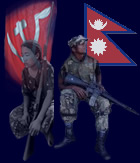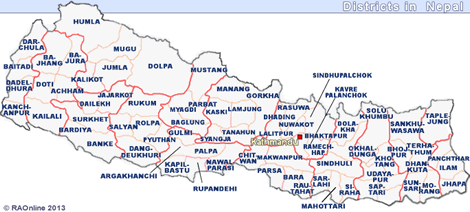
|
| Reports on Nepal's Civil War |
 |
|
| ICRC suspends visits to army detention centres |
June
2005
The International Committee of the Red Cross (ICRC) has put on hold visits to detainees at army barracks throughout Nepal. The suspension comes after the Royal Nepali Army (RNA) allegedly failed to comply fully with the terms of an agreement with the ICRC regarding what are called 'worldwide working modalities.'
These are carefully worded conditions, set down by the Swiss-based organisation, that virtually abstain from making any direct statement against state authorities or other parties to any conflict. The current difficulties centre on the detention of Nepal's Maoist insurgents.
"We have visited persons detained by the RNA since December 2002 and we had some problems as far as the respect of the ICRCs worldwide working modalities for and with detainees are concerned," Friedrun Medert, ICRC's delegation head in the Himalayan kingdom, told IRIN. "We have discussed these problems with the RNA and we felt that the steps it took were not sufficient to redress the situation," Medert added.
| Full story ... |
|
IRIN ICRC
suspends visits to army detention centres (June 2005) - no link |
|
| The soul of a Nepali soldier |
June
2005
While India denies that its security agencies helped arrange meetings between a top Nepali Maoist leader and its political establishment, analysts welcome dialogue with the rebels as a key to ending a seemingly intractable crisis in the neighboring Himalayan kingdom.
According to S D Muni, a widely acknowledged expert on Himalayan affairs, engaging the Maoists is "a good idea". He pointed out that India's ruling elite had initially shied away from the communists, who are in an armed struggle to create a kingless republic, because of pressure from various right-wing lobbies that "are working on behalf of Nepal's King Gyanendra and his coterie".
Speaking
to Inter Press Service in an interview, Muni - who teaches international
relations at the prestigious Jawaharlal Nehru University - identified these
lobbies as "the Indian army, the United States [with which New Delhi works
closely on the Nepal crisis] and members of India's high society, some
of whom have blood ties with the Nepalese monarchy".
| Full story ... |
|
Asia Times Maoists
put India on the spot (June 2005) - no link |
| Nepal losing its way |
May
2005
Friday, as so often happens in Nepal, turned out to be a day of two decisive actions last week, although neither was as tragic as the palace massacre of June 1, 2001, or as dramatic as some of the events thereafter. One took place at Shital Niwas, the building that houses the Ministry of Foreign Affairs, and the other at the headquarters of the Royal Nepal Army.
Secretary Madhu Raman Acharya, the top diplomat at the Foreign Ministry, separately summoned the ambassadors of India and the United Kingdom to his office and conveyed the royal government's strong displeasure over their interference in Nepal's internal affairs. "The government would highly appreciate if friendly governments refrained from suggestive and subjective remarks on the internal political affairs of the kingdom," the ministry said in the aide memoire handed over to the envoys at the end of the meetings. Neither Indian Ambassador Shiv Shankar Mukherjee nor British Ambassador Keith Bloomfield (currently holding the presidency of the European Union in Nepal ) made any public comments about their meeting with Acharya.
| Full story ... |
|
Asia Times Nepal
losing its way (May 2005) - no link |
| The soul of a Nepali soldier |
May 2005
| Courage of soldiers like Captain Amrit Medhasi |
Our media and some human rights group's coverage of a soldier's bravery comes with caveats like 'if only the rest of the RNA were like this man' or the obligatory coupling of Maoist atrocities with 'both sides are massively violating human rights' as if hundreds of summary executions, systematic political killings, drilling holes in pregnant women, and their crackpot vision of a communist State are equivalent to the army's mission whose aim is to restore conditions for a return to democracy.
The Army has had its share of troubling human rights violations but has never embraced a policy encouraging torture and indiscriminate killings. The work of fine soldiers during a war not of their making have been obliterated by relentless ankle-biting and the self-serving agendas of shrill activists and, even worse, our own confused political leadership who slur these soldiers even as they shamelessly crave to command them.
| Full story ... |
| NepaliTimes The
soul of a Nepali soldier (May 2005) - no link |
| Cry, beloved country |
May 2005
| Nawalparasi: Three weeks after the slaughter |
It was two days after the Nepali new year on 16 April and the villagers of this hamlet 20 km southeast of Butwal were getting ready to go to bed. At about 10PM, the Maoists arrived in hundreds. They dragged everyone out of the houses, singled out the men aged 15-39 and executed them without mercy. After that they went on a rampage bombing four houses and burning another 10. They set fire to tractors, to this year's wheat harvest that was piled up for threshing, to cowsheds in which livestock were burnt alive.
| Full story ... |
|
NepaliTimes Cry,
beloved country (May 2005) - no link |
| Gunning for Nepal |
April 2005
| Special report on the bloody civil war |
|
A
TIME special report on the bloody civil war that is tearing the Himalayan
kingdom apart .
With ... Photo Essay: Rebel Territory and Interview with the Maoist leader Prachanda |
|
A distant clattering bounces off the snowy hills as 20 Maoist guerrillas approach a mountain pass deep in Nepal's rebel territory. The sound is too faint to fix as gunfire, so the guerrillas press on up the goat track. Then come the explosions.
The rebels halt and, panting in the thin air, squint up at the forest ridge that now marks the edge of the newest battlefield in their war. "Mortars," says a Maoist political officer. "Eighty-one millimeters," replies a teenage girl who has led the four-hour ascent from the valley floor. "And a chopper." Minutes later, a helicopter marked with the scarlet emblem of the Royal Nepalese Army (R.N.A.) skims the trees above the Maoists. They scatter, crouching as it flies off without spotting them. For now, the danger has passed, but the rebels later claim that the helicopter was on its way back from the village of Kharikot where it had killed scores of unarmed people as they celebrated the ninth anniversary of the Maoist rebellion. The R.N.A. insists the strike was legitimate, boasting that it surprised a group of 800 armed fighters, of whom 25 were killed.
| Full story ... |
|
Time Asia Gunning
for Nepal A TIME special report on the bloody civil war that is tearing the Himalayan kingdom apart Time Asia Photo Essay: Rebel Territory Time Asia Interview with the Maoist leader (April 2005) - no link |
|

|
 |
|
|